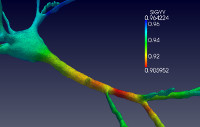International research to lead to better head protection
Antoine Jérusalem, Associate Professor in the Department of Engineering Science, and Alain Goriely, Professor in the Mathematical Institute, both founders of the International Brain Mechanics and Trauma Lab (IBMTL) that focuses research on brain problems, are working in partnership with Professor Michel Destrade from NUI Galway and Dr Jerry Murphy, from Dublin City University, on measuring the engineering characteristics of brain matter.
The aim of this research is to lead to designing better head protection across many areas of life: from sports to military arenas. Medical doctors will eventually be the main benefactors of the research, including specialists in neuro-pathology, neuro-surgery, and neuro-oncology at Oxford’s John Radcliffe Hospital.
Dr Murphy, who recently joined IBMTL, said: ‘Surprisingly little is known about the brain’s most basic aspects, such as its stiffness, its resistance to tear or its response to shearing or twisting forces. By measuring these, we will be able to design better body protection in cars and better helmets in sports’.

Our skulls may be hard, but what’s inside is up to 20 times softer than jelly, which is why researchers at IBMTL are working to uncover the relations between brain-tissue mechanics and brain function, diseases and trauma.
Dr Murphy added: ‘Currently most helmets only deal with head-on impact scenarios. They do not especially protect the area below the temporal bone on the base of the skull, which is thin and vulnerable to side impacts, nor can they protect from twisting motions, which can be very damaging to neurons – special cells that are the brain’s pathways for information’.
Research in this area stems from the US military. It was trying to understand what happens to the brain inside the skull when it is protected by body armour against projectiles but is still damaged by explosion blasts.

‘It could be that the high-pressure wave generated by the explosion bounces longer inside the skull because of the hard shell helmets,’ said Professors Antoine Jérusalem and Alain Goriely. ‘This is another example of a poorly understood mechanical effect that can lead to impairment. Clearly we need to pool resources and expertise together to tackle these questions at cell, tissue and medical levels’.
The IBMTL involves the partnership of more than 22 researchers from 13 main international centres. It is the result of an internationally recognised need to study brain cell and tissue mechanics and their relation with brain functions, disease and trauma.
Professor Jérusalem said: ‘This initiative has been fuelled by the development of interdisciplinary collaborative efforts between engineering, medical sciences, neuroscience, biology, maths, physics and computer science. The collaboration brings together experts from different backgrounds, with their own tools and knowledge. IBMTL will enable experts in different fields, across the globe, to share resources and generate new knowledge’.
Article credit: The Department of Engineering Science
